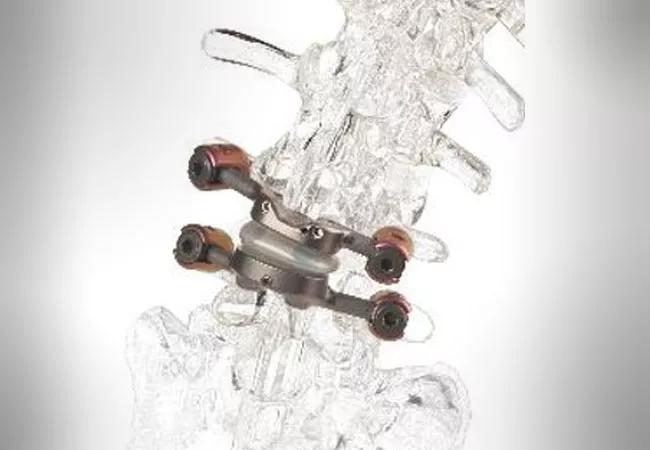Two-year trial results find Total Posterior Spine System to be safe and effective

Posterior facet replacement with the newly FDA-approved Total Posterior Spine (TOPS™) System (Premia Spine) is a safe and effective alternative to lumbar spinal fusion in patients with grade I degenerative spondylolisthesis, offering pain relief without sacrificing physiological movement. These findings, from two years of follow-up in the TOPS FDA investigational device exemption (IDE) multicenter randomized controlled trial (NCT03012776), were published in a preliminary report in the Journal of Neurosurgery: Spine (2023;38[1]:115-125). The trial will follow patients for five years and is due to be completed in 2027.
Advertisement
Cleveland Clinic is a non-profit academic medical center. Advertising on our site helps support our mission. We do not endorse non-Cleveland Clinic products or services. Policy
“Patients receiving the TOPS dynamic stabilization system had better clinical outcomes than those who underwent transforaminal lumbar interbody fusion,” says the study’s senior author, Michael P. Steinmetz, MD, Director of the Center for Spine Health at Cleveland Clinic. “These two-year results were key to FDA approval of the TOPS System as the first alternative to spinal fusion for grade I degenerative spondylolisthesis.” The FDA approved the system on June 15.
Several randomized clinical trials have examined whether patients with degenerative spondylolisthesis should be surgically treated with decompression alone or with decompression plus fusion. The results have been mixed, with one trial showing slightly better outcomes with fusion added, and others showing no significant clinical benefit. Both options have significant disadvantages: reoperation rates tend to be higher for patients treated with decompression alone, but fusion immobilizes the fused spinal segments, which frequently leads to adjacent segment degeneration.
A different surgical focus for treating spondylolisthesis and stenosis is replacing facet joints. These small knobs resting on the superior articular processes at the back of the spine play a critical role in spine mobility. With loss of disc height from degeneration, the facet joints can develop abnormal articulation, leading to osteoarthritis, spinal stenosis and degenerative spondylolisthesis.
TOPS is an artificial facet replacement device consisting of two titanium endplates connected by a covered articulating mechanism. It comes ready for insertion with pedicle screws.
Advertisement
Originally developed 20 years ago, TOPS underwent design refinements and was commercially launched in Europe in 2012. Over the years, small nonrandomized case series assessing TOPS have been published outside the U.S., some with more than 10 years of follow-up. They indicate that the device confers clinical improvement and radiological stability.
The TOPS IDE trial began in 2017 and is being conducted at three dozen locations in the U.S. Dr. Steinmetz serves as the trial’s site principal investigator at Cleveland Clinic, one of the largest enrollers of participants in the study.
The preliminary two-year report included data on 249 patients randomized 2:1 to be implanted with TOPS (n = 170) or to undergo transforaminal lumbar interbody fusion (n = 79). All patients had single-level pathology between L2 and L5, moderate or severe spinal stenosis and degenerative spondylolisthesis, and predominant leg (rather than back) symptoms. Both cohorts underwent decompression before receiving their device.
The prespecified primary composite endpoint at 24 months after intervention required that all the following were met: no reoperation or lumbar injection, Oswestry Disability Index (ODI) reduction of at least 15 points, no new or worsening neurological deficit, no major device-related adverse event and no fusion status failure.
TOPS was found to perform better than fusion in multiple measures at two-year follow-up:
Advertisement
Leg pain significantly improved in both groups to a similar degree: 90% of the TOPS group and 88% of the fusion group met prespecified criteria.
Whereas preoperative range of motion was similar between the groups preoperatively, it improved or was maintained (depending on the measure) at 12 and 24 months in the TOPS group while it declined significantly at 12 and 24 months in the fusion group.
“Facet arthroplasty with TOPS demonstrated significant and sustained improvement in pain and disability measures, with equal or significantly better outcomes than fusion at two years,” summarizes Dr. Steinmetz. “It also has the advantage of maintaining spine mobility.”
He notes that in the TOPS group, none of the reoperations were for adjacent-level disease and only two were device-related (one each for pedicle screw loosening and misplacement). He says that it is too early to tell if adjacent segment degeneration ― frequently seen after fusion ― will be a problem down the road for this group.
He cautions that the encouraging results of this trial may not be applicable to conditions other than grade I degenerative spondylolisthesis, as other potential indications were not tested. He expects that future case series will address such possibilities.
“With FDA approval of TOPS as the first device for facet replacement, we will be able to offer patients what early results indicate is a better alternative to fusion for lumbar spondylolisthesis,” Dr. Steinmetz concludes.
Image at top: The TOPS device as implanted in a spine model. Courtesy of Premia Spine. © Premia Spine Ltd.
Advertisement
Advertisement

Safety and efficacy demonstrated in largest case series reported to date

Tool correlates well with sagittal vertical axis and quality-of-life measures

Insights from 15 years of experience of Cleveland Clinic’s spine tumor board

Success for these complex operations requires judicious patient selection and presurgical patient optimization

Meta-analyses signal an opportunity to reshape risk stratification and surgical protocols for these comorbidities

A host of factors shape when to intervene and which of three primary procedures to use

Minimally invasive approach is gaining prominence as a fast and safe outpatient procedure

Insights on leveraging collaboration and advocacy to develop and conduct needed trials